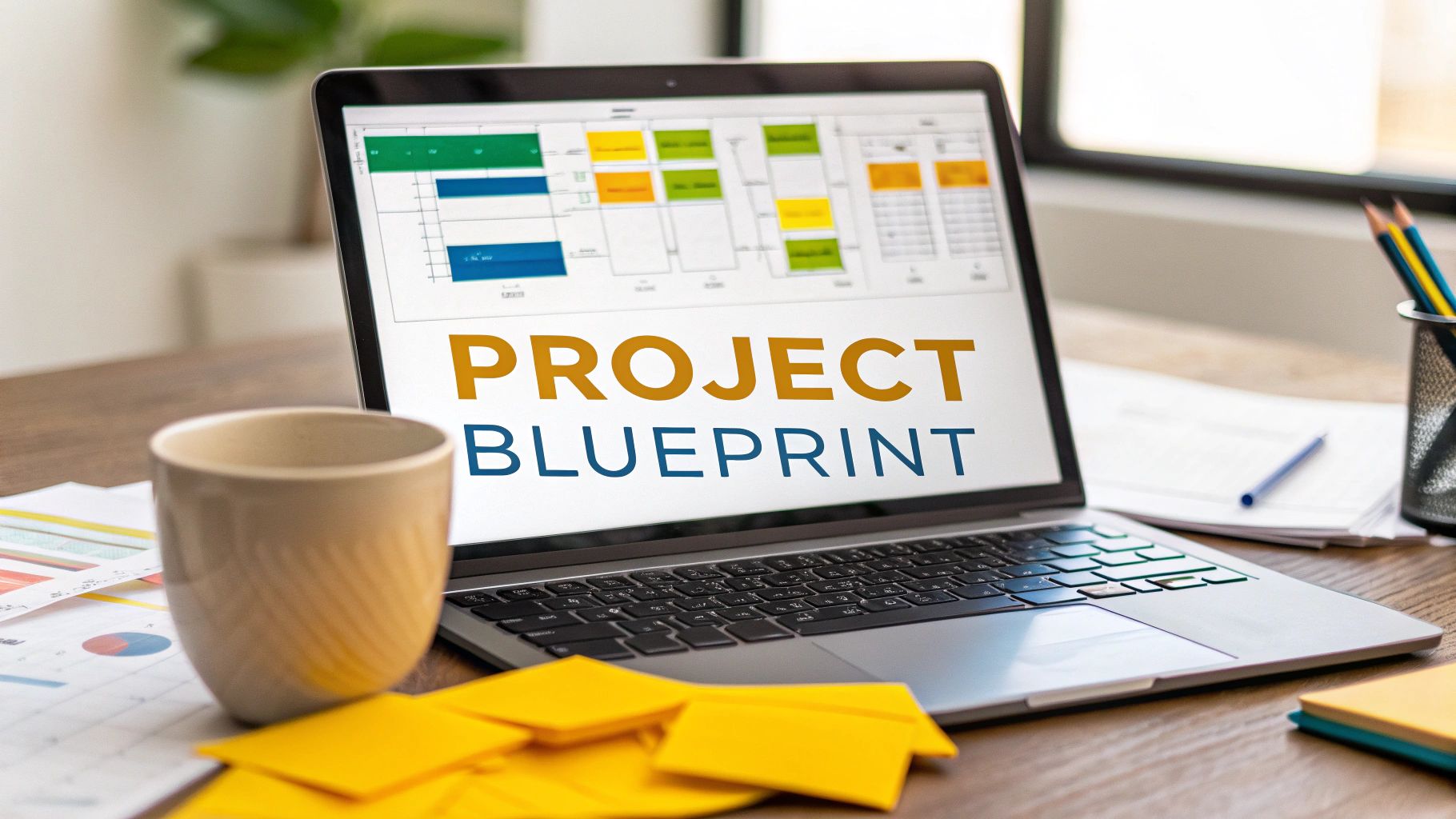Effective Project Planning for Software Development

Before you even think about writing a single line of code, you have to nail down your project plan. This is where you take a great business idea and turn it into a concrete roadmap. Get this right, and you've built a strong foundation that keeps everyone focused, aligned, and pulling in the same direction. Skip it, and you’re setting yourself up for confusion and chaos down the line.
Building Your Project’s Foundation for Success

I've seen countless software projects go off the rails long before the first sprint ever started. The culprit is almost always a weak foundation—a failure to translate a high-level vision into something the whole team can understand and measure. This early phase isn't about diving into technical specs; it's about getting crystal clear on what you're building and why.
Your first job is to turn vague business wishes into tangible goals. A request to "improve customer engagement" is a classic example of a goal that's too fuzzy to be useful. A much better, more actionable goal would be: "Increase daily active users by 15% within six months of launch." Now that's a target your team can actually aim for.
The Art of Stakeholder Interviews
To build this solid foundation, you need to talk to people. A lot of people. Your first step is to conduct thorough stakeholder interviews, and your mission is to dig deeper than just what they say they want. You need to uncover the why behind their requests. Asking the right questions here can reveal hidden assumptions that would have become major roadblocks later on.
And don't just talk to the project sponsor. Cast a wider net. A good stakeholder list includes:
- Executive Sponsors: These are the people funding the project. They care most about ROI and how the project aligns with the big-picture company strategy.
- End-Users: The folks who will actually use the software every day. Their feedback is gold for getting the usability and features right.
- Marketing & Sales: They need to understand the product's value so they can figure out how to sell it.
- Support & Operations: These are the teams who will deal with customer issues and keep the lights on after launch. Their insights can save you from a world of future pain.
When you're in these conversations, stay away from leading questions. Don't ask, "Don't you think a real-time dashboard would be great?" Instead, try something more open-ended, like, "How do you track performance right now, and what information would make your job easier?" This approach gets you so much more insight into their actual pain points.
Here's a key takeaway from my experience: The goal of a stakeholder interview isn't to collect a feature wish list. It's to truly understand the business problem you're being asked to solve. A feature request is just a proposed solution—and it might not be the best one.
Crafting Your Project Charter
All the juicy insights you've gathered from your stakeholder interviews should feed directly into your project charter. Don't dismiss this as just more paperwork. Think of the charter as your project's North Star. It's a short, high-level document that officially kicks off the project and gives the project manager the authority to move forward.
A solid project charter nails down the "what" and the "why" before anyone gets bogged down in the "how." It solidifies that shared vision and becomes your go-to reference whenever arguments or scope creep pop up.
For a new mobile app feature, a practical project charter might look something like this:
- Project Vision: A simple, one-sentence summary. For example, "To build a mobile check-deposit feature that cuts down on branch visits and makes our users' lives easier."
- Measurable Objectives: Specific, quantifiable goals. Think "Achieve a 20% adoption rate among active mobile users in the first quarter" or "Decrease in-branch check deposits by 10%."
- High-Level Scope: A quick rundown of what's in and, crucially, what's out. For instance, "The initial release will support personal checks only; business checks are out of scope for V1."
- Key Stakeholders: A list of the main decision-makers and what their roles are.
Putting in this foundational work—defining clear goals, talking to the right people, and creating a solid charter—sets the stage for everything else. It ensures every technical decision and every line of code serves the core business objectives. With this foundation in place, you’ve positioned your project for success right from day one.
Defining Scope to Prevent Project Overload

Scope creep is the project killer that sneaks up on you. It starts with a simple, well-intentioned request—"Could we just add one more button?"—and suddenly, you're months behind schedule and completely over budget. I've seen it happen countless times. This is why a core part of project planning for software development is your ability to draw a firm line in the sand and stick to it.
This is the moment where you translate the big ideas from your project charter into the nuts and bolts of what your team will actually build. Without this step, you're essentially flying blind. The numbers don't lie: IT projects frequently run over budget by 75% and get delayed by an average of 46%, often because the initial boundaries were fuzzy at best. You can see more data on how poor planning affects projects over at PM360Consulting.ie.
Break It Down with a WBS
Your most effective weapon against scope creep is a Work Breakdown Structure (WBS). It’s a beautifully simple concept: take the massive end goal and break it down into smaller, more manageable pieces. Think of it as turning an intimidating mountain into a series of small, moveable rocks.
Let's say you're tasked with creating a new mobile banking feature for instant fund transfers. A basic WBS might start like this:
- User Authentication: How do we confirm the user is who they say they are before they send money?
- Recipient Management: What's the process for adding, editing, and choosing someone to pay?
- Transfer Execution: This is the core engine that actually moves the money.
- Notifications: How do we let the sender and receiver know the transfer status?
From there, you dig deeper. "User Authentication" could split into "Biometric Login Integration," "PIN Verification," and a "Forgot PIN Flow." You keep breaking things down until you have individual tasks that are easy to grasp, estimate, and hand off to a developer.
The real power of a WBS is that it forces you to be specific. If a new feature request doesn't naturally fit into your existing structure, it’s a massive red flag that it’s probably out of scope.
Put It in Writing with a Scope Statement
Once your WBS is solid, it's time to draft a crystal-clear scope statement. This document is your shield. It needs to be direct, unambiguous, and leave zero room for interpretation. It’s a formal record of what the project will deliver and, just as critically, what it will not deliver. Our team has put together a detailed guide on how to define project scope that offers more tactics for getting this right.
Your scope statement should build directly from your WBS, clearly listing all the key deliverables, features, and functions. But the secret sauce is the "Exclusions" section.
Example Scope Exclusions for a Mobile Transfer Feature:
- This release will not support international transfers.
- The system will not include a "request money" feature; it will only support sending funds.
- Integration with third-party payment apps (like PayPal or Venmo) is out of scope for version 1.0.
Having these exclusions documented and signed off on by stakeholders is your best defense. When that inevitable "could we just..." question comes up, you can point directly to the agreed-upon scope statement. It immediately shifts the conversation from a casual ask to a formal change request, forcing a serious discussion about the impact on the timeline and budget. Getting this right is how you turn a massive undertaking into a series of achievable wins.
Estimating Timelines and Resources Without Guesswork

Let's be honest. For a lot of people, estimating a software project's timeline and budget feels more like reading tea leaves than a science. I've seen countless new project managers fall back on gut feelings, and that's a fast track to missed deadlines and some very uncomfortable meetings with stakeholders. Real project planning for software development means you have to move past the guesswork.
The idea isn't to just pull a date out of thin air. It’s about building a defensible plan that’s grounded in the actual work you've scoped out, the team you have on hand, and the inevitable curveballs that every project throws. This is where a detailed Work Breakdown Structure (WBS) really earns its keep—it’s the bedrock for any estimate that holds water.
Choosing Your Estimation Model
There's no silver bullet for estimating a software project. The best method really hinges on the nature of your project and how your team operates. If your requirements are locked down and well-defined, a more traditional approach might be perfect. But for most modern projects, where things are more fluid, agile methods usually win out.
Let's look at two common ways to tackle this: PERT and Story Points.
- Program Evaluation and Review Technique (PERT): This model is a lifesaver for complex projects with a web of dependent tasks. For every task, you come up with three numbers: an optimistic (O), a most likely (M), and a pessimistic (P) estimate. The final figure is a weighted average using the formula (O + 4M + P) / 6. It’s a smart way to factor in uncertainty.
- Story Points (Agile): Instead of talking in hours or days, agile teams often use story points. Think of them as relative units of effort. A task that’s 2 points is roughly double the work of a 1-point task. This brilliantly separates the estimate from a specific developer's speed and focuses the conversation on overall complexity, risk, and effort.
I often lean toward story points because of their flexibility. It gets the team talking and thinking collaboratively about what it will take to get something done, rather than getting bogged down in hour-by-hour predictions that are almost never right anyway. For a deeper dive, our guide on creating an app development project plan has more on how to structure your timeline effectively.
Building a Smart Resource Plan
Resource planning goes way beyond just sticking names next to tasks on a spreadsheet. A truly solid plan maps specific skills to the work packages you defined in your WBS. When you do this proactively, you can spot potential traffic jams long before they bring everything to a halt.
Imagine a feature needs a senior backend dev who’s a wizard with database optimization. If you only have one person with that skill set and they're booked for three critical tasks at the same time, you’ve just uncovered a massive risk to your schedule.
A strong resource plan should clearly outline:
- Role Requirements: What exact skills are needed for each piece of work (e.g., Senior iOS Developer, Mid-level QA Tester, UX Designer).
- Availability: What percentage of time each person can realistically dedicate to your project, accounting for their other projects, meetings, and company holidays.
- Dependencies: Which tasks are waiting on a specific person's expertise before they can be finished.
By mapping this all out, you get a bird's-eye view of where you might be overloading a key team member or where you need to bring in more help to keep the project flowing.
A critical mistake I see is creating a resource plan based on titles alone. A "developer" is not a fungible resource. Understanding the unique strengths and specialties of your team members is the secret to accurate allocation and avoiding roadblocks.
Handling Buffers the Right Way
Every experienced PM knows: things go wrong. It's a given. The question isn't if you need a buffer, but how you build it into the plan intelligently. Just slapping a flat 20% buffer onto the end of the timeline is a lazy approach that often just hides sloppy estimation work.
A much smarter strategy is to tie your buffers to risk. Pinpoint the parts of your project with the most unknowns—maybe it’s integrating with a new third-party API or building a complex algorithm. Those are the areas that get a more significant buffer. For the routine, well-understood tasks, a much smaller buffer will do. This targeted approach gives you a schedule that’s not just padded, but realistically prepared for the road ahead.
Picking the Right Tools and Development Methodology

The tools and methodology you choose are the engine of your software project. Get this combination right, and you’ll build momentum and keep everyone on the same page. Get it wrong, and you're staring down the barrel of constant friction and a thoroughly confused team. This isn't just about picking the trendiest software; it's about finding a rhythm that fits the unique demands of your project.
This decision is so critical that it's fueling a massive market. The project management software industry is expected to hit $7.24 billion by 2025 and an incredible $12.02 billion by 2030. That explosion in growth tells you everything you need to know: companies are betting big on these tools to get work done right. In fact, 82% of organizations already use them to boost their efficiency. You can dig deeper into these numbers over at the monday.com blog on project management statistics.
Agile vs. Waterfall: Which Path to Take?
One of the first forks in the road you'll encounter during project planning for software development is your core methodology. This decision dictates the entire tempo of your work. The two big players here are Waterfall and Agile, and they couldn't be more different.
The Waterfall model is your classic, linear approach. You complete one full phase—like requirements gathering or design—before you even think about starting the next. It’s highly structured and really shines when your project requirements are crystal clear, locked down, and unlikely to change. Think of it like building a house; you need the complete blueprint before laying the foundation.
On the other hand, Agile methodologies like Scrum and Kanban are built to embrace change. Work gets broken down into small, manageable cycles called sprints. This allows for constant feedback and quick pivots, making it a perfect fit for projects where the final destination isn't entirely clear from the start. You're not building a house with a blueprint; you're exploring a new continent and drawing the map as you go.
Choosing your methodology isn't about which one is "better." It's about which one honestly reflects the reality of your project. A well-defined, rigid project will flounder under the flexibility of Agile, while an exploratory one will be completely suffocated by Waterfall's structure.
To make this choice clearer, it helps to see a side-by-side comparison of how they operate.
Comparing Software Development Methodologies
Every team needs to weigh the pros and cons of these two foundational approaches. This table breaks down their key characteristics to help you decide which one aligns best with your project's goals and team dynamics.
| Characteristic | Waterfall | Agile (Scrum) |
|---|---|---|
| Flexibility | Rigid and resistant to change once a phase is complete. | Highly flexible; changes are welcomed and adapted into future sprints. |
| Testing | A distinct phase that occurs after development is finished. | Integrated continuously throughout the entire development process. |
| Customer Involvement | Limited to the initial requirements phase and final delivery. | Constant collaboration and feedback after each sprint. |
| Delivery | A single, final product is delivered at the end of the project. | Functional pieces of the software are delivered incrementally. |
As you can see, the right choice depends entirely on your project's predictability and your customer's desire to be involved throughout the process.
Selecting Your Project Management Software
After you've landed on a methodology, you need a platform to bring it to life. A great project management tool is so much more than a digital to-do list; it's your team's central hub. It provides a single source of truth that keeps everyone, from developers to stakeholders, perfectly in sync.
When you're shopping around, try to look past the flashy marketing and focus on the features that will actually help your team get work done.
Essential Software Features:
- Task Management & Dependencies: You need to create tasks, assign them, set deadlines, and—critically—link dependent tasks so that one thing can't start until another is finished.
- Customizable Workflows: The tool should bend to your process, not the other way around. Look for the ability to create custom stages that mirror your team's real-world flow (e.g., "Backlog," "In Progress," "In Review," "Done").
- Visual Roadmaps & Gantt Charts: For managers and stakeholders, seeing a high-level visual timeline is non-negotiable. It’s the best way to track progress and spot potential roadblocks before they become serious problems.
- Powerful Reporting: You have to track key metrics like sprint velocity, bug counts, and completion rates. Good reporting helps you identify trends and make decisions based on data, not just gut feelings.
For teams leaning into an iterative workflow, it's worth checking out our guide on Agile software development best practices for more in-depth strategies. At the end of the day, the best tool is the one your team will actually use consistently. Always factor in your team's size, technical savvy, and the project's complexity before you make the final call.
Mastering Risk Management and Stakeholder Communication
Every good plan accounts for both sunny days and storms. In software development, though, it’s the storms you don't see coming that can really sink the ship. A truly effective project plan for software development isn't just about the ideal path; it's about preparing for what could go wrong so you can keep things on track, no matter what surprises pop up.
This foresight begins with proactive risk management. It’s not about being a pessimist, but a realist. You need a solid process to spot, evaluate, and plan for potential problems before they blow up your timeline.
Building Your Risk Register
Your most important tool for navigating uncertainty is the risk register. Think of it as a living document, a central hub for tracking every potential threat to your project's success. The real trick here is to look past the obvious stuff, like a server going down, and dig for the more subtle risks that can quietly eat away at your progress.
Get your team in a room and start brainstorming. Encourage them to think outside the box—what could really go wrong here?
Examples of Subtle Software Project Risks:
- Key Person Dependency: What’s the plan if your lead backend developer quits tomorrow? Is all that critical knowledge just in their head?
- Creeping Technical Debt: Are we taking shortcuts now that will force a painful, time-consuming refactor six months from now?
- Shifting Market Priorities: What if a competitor launches a game-changing feature that suddenly makes our current backlog feel dated?
Once you have a list, you'll want to score each risk. How likely is it to happen, and what's the potential damage if it does? This simple exercise immediately helps you prioritize. A high-impact, high-likelihood risk needs a concrete mitigation plan today. A low-impact, low-likelihood one? Maybe you just keep an eye on it.
The most dangerous risk is the one you haven't identified. A comprehensive risk register is your best defense against project surprises, transforming unknown threats into manageable challenges.
Crafting a Proactive Communication Plan
Just as critical as managing risks is managing expectations. A solid communication plan is the foundation for healthy stakeholder relationships. It’s essentially an agreement on who gets what information, how often they get it, and how it's delivered. Getting this right upfront prevents those dreaded "So... any updates?" emails.
The secret is to customize your communication for each audience. They don't all care about the same things.
- For the C-Suite: They need the big picture, fast. Think high-level executive summaries focusing on major milestones, budget status, and key performance indicators (KPIs). A monthly email or a simple dashboard view usually does the trick.
- For the Development Lead: This is where you get into the weeds. Daily stand-ups, detailed sprint reports, and full access to the project backlog are crucial for them to steer the technical team effectively.
- For the End-Users or Product Owners: They need to see and feel the progress. Regular sprint demos where they can actually click around and interact with new features are infinitely more valuable than a static report.
Here’s a sobering thought: while 77% of high-performing projects use project management software, a shocking 54% of organizations still lack the ability to track real-time KPIs. That points to a massive communication breakdown. And with 47% of Agile projects hitting delays or budget overruns, clear and consistent communication has never been more vital. You can dig into more of these project management challenges and statistics on IseoBlue.com.
By defining these communication channels from the start, you ensure everyone feels included and confident in the project's direction. You’ll spend far less time putting out fires and more time actually building great software.
Answering Your Top Software Project Planning Questions
No matter how meticulous your plan is, you're going to run into questions. Software development is a dynamic field, and the real test of a great project manager is how they navigate the inevitable bumps in the road. I've seen a lot over the years, so let's dig into some of the most common questions that come up.
Think of this as practical advice from the trenches, not just theory. Getting a handle on these scenarios will help you stay flexible and keep your project on track when things get tricky.
How Do You Handle Changing Requirements Mid-Project?
This is the classic question, isn't it? It’s probably the one thing every software project deals with. The trick isn't to fight change—that’s a losing battle. Instead, you need to manage it through a formal change control process.
Once the initial scope is locked, any new request needs to be properly documented and weighed. It can't just be a quick "by the way" conversation in the hallway.
A solid process usually involves these steps:
- Submit a Formal Request: The stakeholder puts the change in writing, outlining what they need and, crucially, the business reason behind it.
- Run an Impact Analysis: You and your technical lead need to figure out what this change really means for the scope, timeline, budget, and team.
- Get a Clear Decision: Present your analysis to the project sponsor or a steering committee. They get the final say—approve, reject, or put it on the back burner for later.
This structure is your best defense against scope creep. It ensures that every single change is a deliberate, informed decision, not an unplanned detour that throws your entire schedule into chaos.
What's the Most Common Planning Mistake You See?
If I had to pick just one, it’s not getting enough stakeholder input right at the beginning. It's easy for teams to get swept up in the excitement of the technical side and jump into building things before they've truly absorbed the business problem they're supposed to be solving.
When you fail to identify and talk to all the key stakeholders—from the executive footing the bill to the customer service reps who will deal with user issues—you’re setting yourself up for failure. This leads to crossed wires, endless rework, and a final product that, while technically impressive, doesn't actually help the business.
A project that doesn't meet user needs is a failed project, no matter how elegant the code. That failure almost always starts with not talking to the right people at the very beginning.
How Detailed Should a Work Breakdown Structure Get?
Your Work Breakdown Structure (WBS) needs to hit a sweet spot. You want tasks broken down enough to be manageable, but not so granular that you're just creating administrative busywork. The goal is to get to a "work package"—the smallest item in your WBS—that you can estimate and assign with confidence.
A great rule of thumb here is the 8/80 rule. It’s a simple but powerful guideline.
The idea is that no single task or work package should take less than 8 hours of effort or more than 80 hours (about two standard work weeks).
- Under 8 hours? You're probably micromanaging. Group it with something larger.
- Over 80 hours? That task is a beast. It’s too complex to estimate accurately and needs to be broken down into smaller, more predictable pieces.
Following this rule helps you maintain a project plan that’s detailed enough to be useful but not so bogged down that it’s impossible to manage. It's one of the best ways I know to improve the accuracy of your timeline.